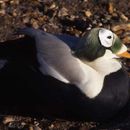en
names in breadcrumbs


Although their winter residence is still unknown, some researchers suspect it is somewhere in the Bering Sea and possibly on southern edge of the ice pack. The ducks are sometimes seen resting on floating ice.
Perception Channels: visual ; tactile ; acoustic ; chemical
The spectacled eider is uncommon. This is mostly due to the small location of where the bird is found. The bird population has been reported as declining in the past. To counteract this decline there have been attempts to raise the birds in captivity, but these efforts are limited by the difficulty of obtaining the eggs during the arctic summer. Spectacled eiders were first hatched in captivity in 1976. The major concern for the bird now is determining the location of the non-breeding habitat. This is important to know because the habitat of this bird could be unintentionally destroyed, especially if it is in a very concentrated area.
IUCN Red List of Threatened Species: least concern
Humans have hunted the spectacled eider in the past. Eskimos have stated that this is the best tasting eider. The pelts and eggshells have also been used for decorative purposes. Another benefit of the eider is the esthetic value that comes from seeing such an unusually colored bird.
The ducks are omnivorous. The majority of their diet includes mollusks, such as Razor clams. They also feed on terrestrial and freshwater plant material. Juveniles have been found to eat caddis fly larvae. The spectacled eider rarely dives and is seen mostly dabbling for food.
The Spectacled Eider is found along the west coast of Alaska, between Point Barrow and the Lower Kuskokwim River. They are most abundant in the Yukon Delta.
Biogeographic Regions: nearctic (Native )
The breeding habitat of the spectacled eider is generally near shores, lakes, and deltas along the coast of Alaska. The ducks prefer lowland tundra with small ponds and close proximity to the salt water. They require high grasses to build the nests. The non-breeding habitat is uncertain.
Terrestrial Biomes: tundra
Aquatic Biomes: coastal
Average lifespan
Status: wild: 106 months.
These ducks are sexually dimorphic. With wings folded, the adult male duck is 255-267 mm long, while the female is 240-250 mm. The weight is approximately 1.63 kilograms for males and 1.6 kilograms for females.
The spectacled eider differs from other eiders in that its feathers extend down to the nostrils on the bill. This bill is bright orange on males and blue-gray on females. Both sexes have bright yellow feet. Male eiders, however, have a black chest and pale green head. They are best distinguished by their white patches around the eyes, which are encircled by black feathers to give the appearance of spectacles. Female are drab in comparison. They are brown with black discontinuous streaks and bars of brown. The females also have patches round the eyes, but they are light brown.
Range mass: 1600 to 1630 g.
Other Physical Features: endothermic ; bilateral symmetry
Breeding generally occurs on the Alaskan coast and in northeastern Siberia. Pair bonds form at the beginning of each breeding season, during which there is constant contact between members of a pair. These bonds break immediately after the breeding season is over. To initiate breeding, females perform inciting movements and calls. Males respond by performing ritualized displays that include exposing the blackened chest. Nesting occurs in the grass flats or on the periphery of tundra ponds. The nest is built by the female and is lined with grass stems and a large amount of down. Once eggs are laid, the female is very protective of the nest and will often be extremely hesitant to leave, even allowing people to touch her. Clutch sizes average 4.5 eggs and range in number from one to eight. An egg is laid every other day. Incubation lasts for approximately 24 days while the fledging period lasts for 53 days. Drakes are able to mate when they are two years old.
Behavior:
Average eggs per season: 4.5.
Average time to hatching: 24 days.
Average fledging age: 53 days.
Key Reproductive Features: iteroparous ; gonochoric/gonochoristic/dioecious (sexes separate); sexual ; oviparous